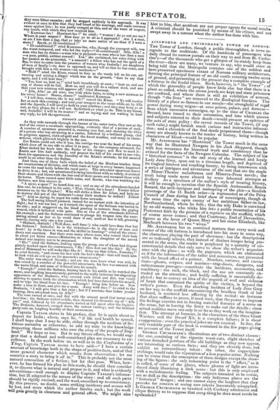AINSWORTH AND CRUIESHANICS TOWER Or LONDON, THE Tower of London,
though a public thoroughfare, is terra in- cognita to the multitude. Of the hundreds of passengers who daily thread its narrow portals on their way to and from St. Catha- rine's—of the thousands who get a glimpse of its stately keep from the river—there are many, we venture to say, who would stare at being told that the Metropolis contains one of the noblest and best-preserved specimens extant of Norman military architecture, forming the principal feature of an old castle covering twelve acres of ground, and presenting at the present day a complete example of a fortress in the feudal times. Such, however, is " the Tower " ; of which the generality of people know little else but that there is a place so called, where the crown jewels are kept and state prisoners are confined, and where there is still an exhibition of armour, though "the lions" are removed to the Zoological Gardens. The history of a place so famous in our annals—the stronghold of regal power during many reigns—at once prison, palace, and fortress— from which successive sovereigns, up to the time of CHARLES the Second, have issued to their coronation, and into which queens and subjects entered to their death—would present an epitome of the acts of state policy : the secret records of the Tower, (if any such exist,) might furnish much curious and instructive informa- tion; and a chronicle of the foul deeds perpetrated there—though many are already known to the reader of history, being written in characters of blood—would be popular.
Mr. AINSWORTH has "illustrated" the Tower much in the same way that he illustrated Newgate in his Jack Sheppard, though with less reverence for historical truth and consistency than he evinced for the facts of the Newgate Calendar. The subject of his "historical romance" is the sad story of the learned and lovely Lady Jane Grey, spun out to a tiresome length, and deprived of its tragical interest and touching beauty, by being interwoven with a series of intrigues and adventures of the sort that are the staple of Minor-Theatre melodramas and Minerva-Press novels ; the trash being made more absurd by some laboured attempts at drollery As a specimen of the author's style of treating history, it will be enough to mention that the Spanish Ambassador, Simon Renard, the arch-intriguer and mainspring of the plot—a fiendish personage of the 0. Smith order—is represented as of the Privy Council of Jane during her brief show of sovereignty, though at the same time the open enemy of her ambitious father-in-law, Northumberland, whom he foils ; that the wily Duke is outwitted by an old woman, who tricks him into a public recantation of his Protestant faith by the promise of a reprieve on the scaffold, which of course never comes ; and that Cmirtenay, Earl of Devonshire, figures as the lover of Queen Mary and her sister Elizabeth, like Macheath between his two "wives."
Mr. AINSWORTH has so contrived matters that every nook and corner of the old fortress is introduced into his story in some way, the characters playing the part of showmen: but the descriptions are so tediously minute, that instead of distinct images being pre- sented to the sense, the reader is perplexed by a quantity of cir- cumstancial details that only serve to show the writer's acquaint- ance with the place : so with the pageants, which are elaborated as if for the information of the tailor and seamstress, not presented with the broad effect of a painter. Murders, tortures, and execu- tions—ghosts, corpses, and maniacs—trap-doors, dungeons, and subterranean passages—constitute the incidents, accessories, and machinery : the rack, the block, and the axe are constantly ob- truded on the attention ; and bodily suffering is successfully de- picted; but to convey an idea of the anguish of soul and sickness of heart that consumed the spirits of the victims, is beyond the writer's power. Even the shocking incident of Lady Jane Grey on her way to the scaffold encountering the headless trunk of her husband, is rendered less affecting by the recital: an instance that alone suffices to prove, if need were, that the power to impress the feelings consists not in forcing material features of a scene on the sense, but in leaving the fancy to make out the details ; since actual realities move one only in so far as they work on the imagina- tion. The attempt at humour, in the characters of the three Giant Warders and the Dwarf Xit, is a complete failure ; it is sheer exaggeration even the practical jokes are not comical. In fine, the only readable part of the book is contained in the few pages giving an account of the Tower itself.
GEORGE CRUIESHANK'S illustrations are of two distinct classes : the one, consisting of the vignette wood-cuts, slight sketches of various detached portions of the old buildings as they now appear, are interesting as curious facts ; and they are cleverly done, but exhibit no extraordinary talent : the other, the copperplate etchings, would ruin the reputation of a less popular artist. Nothing can be worse than the conception of these designs except the draw- ing of the figures : the only redeeming point is the " effect," as it is called, of some of the plates, where gleams of light are intro- duced dimly illumining a dark scene : but this is only employed with a melodramatic feeling. The subjects intended to be comic, are as dull as the descriptions : the only ludicrous plates are the " historical " designs ; and one cannot enjoy the laughter that they provoke for concern at seeing rare talents lamentably misapplied. Is GEORGE CRUIRSHANK so besotted with Cockney admiration and clique flattery as to suppose that every thing he does must needs be applauded 2






























































 Previous page
Previous page